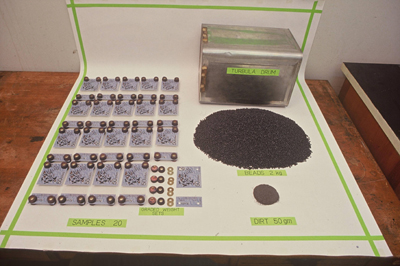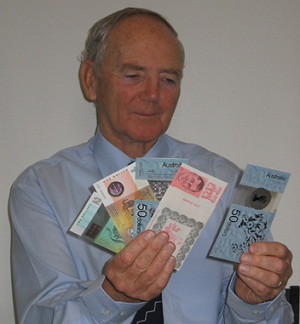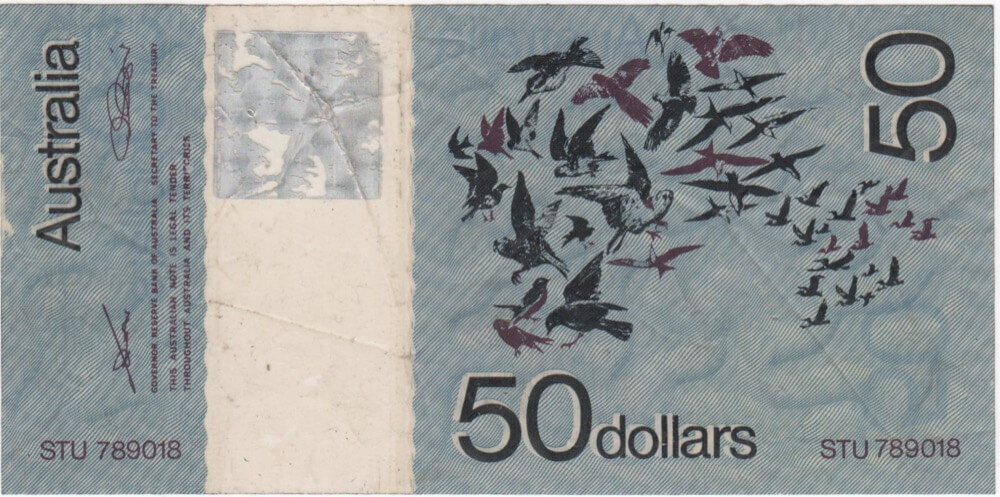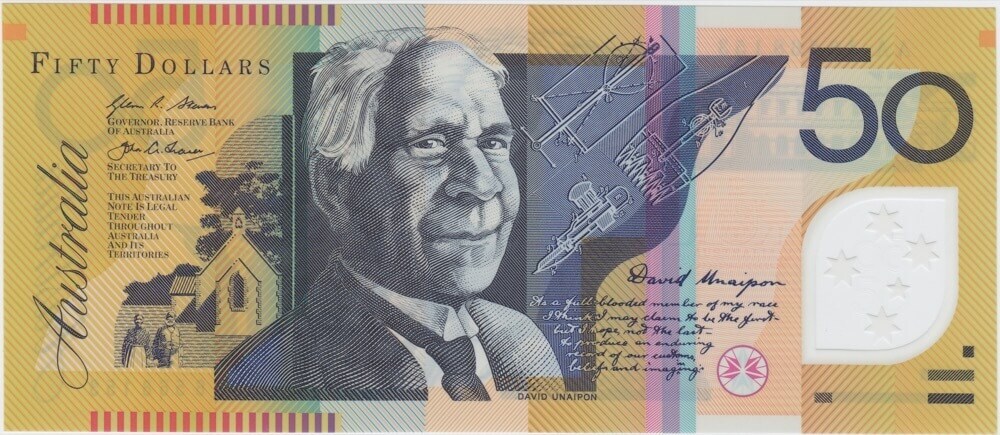1977 $50 Polymer CSIRO Test Note Mark 2a / S2X1 Fine
1977 $50 Polymer CSIRO Test Note Mark 2a / S2X1 Fine
Mark 2a / S2X1 Fine STU 789018
Indelibly tied to the development of polymer currency in Australia.
The evolution of the technology used to print Australia's polymer banknotes can be traced back to a series of counterfeit paper $10 notes discovered in 1966.
Once all of the counterfeit $10 notes had been tracked down and destroyed, once the perpetrators that had printed them had been put behind bars, the Governor of the Reserve Bank of Australia, Dr Herbert (Nugget) Coombs, resolved to ensure those unseemly events were never repeated. Nugget was convinced that science should be able to put much more distance between what the forgers were apparently so easily able to simulate, and what the bank could produce.
A think tank to discuss the challenge was called in 1968, made up of several scientists from the Commonwealth Scientific and Industrial Research Organisation (CSIRO) as well as a number of universities. In total, Coombs enlisted seven top Australian scientists, five physicists and two chemists. The two chemists were Jerry Price (who went on to become chairman of CSIRO), and Sefton Hamann, chief of the CSIRO Division of Applied Chemistry.
One of the key points taken away from this first meeting, made by a representative from Kodak Australia, was that if the new banknotes could be photographed, they could also be printed and forged.
For this reason, the scientists in the think tank resolved to come up with a security device that couldn't be photographed (and thus couldn't be forged) - it is from this idea that the optically variable device (OVD) was born.
David Solomon was Senior Principal Research Scientist at CSIRO, he led the CSIRO team that developed the use of plastic films and OVDs. His industrial achievements are best exemplified by the Australian Bicentennial $10 banknote, where he was a principal inventor as well as the project leader from the inception through to the technology transfer stage of the project. Among Solomon's published recollections of the early days of the development of polymer banknote technology is the following statement:
"We produced these devices in large quantities to demonstrate the practical nature of the concept.
We built a production plant in secret and printed a design provided by the RBA, birds in flight, using our plastic film.
However the number of ideas was beginning to confuse the Reserve Bank and a freeze was put on further designs. So we focused on Diffraction gratings (Holograms), Moire interference patterns, photochromic compounds and a label. The latter was detectable by a machine."
Solomon then proposed a massive innovation - to completely replace the paper traditionally used in the printing of notes with a plastic film. The presence of a clear area alone would force the forger to use plastic, and no commercially available film was available.
Solomon's group made their own polymer substrate, and it was unique. After it had been made opaque, the laminate developed by CSIRO could be printed on conventionally, after which security features were applied. The most notable features of the early test notes were described as being the see-through panel and the hologram.
Testing the First Polymer Notes
At one stage, Solomon's team included no less than 31 staff. In secret at a shed at the CSIRO's Port Melbourne site, they built a pilot production line and produced the equivalent of 50 million banknotes. and 1.25 million OVDs - this was to prove to the Reserve Bank that these revolutionary ideas were not only innovative, but were also practical - they could be produced economically.
Testing of the substrate, laminate and security devices was a particular challenge: as any and all issues regarding printing need to be resolved before any notes enter circulation, it obviously isn't possible to trial a banknote "in the field", to issue them into circulation and fix the problems after that.

One piece of lab equipment the secret team at CSIRO used to measure the durability of their polymer test notes was called the "Turbula", a machine that simulated the rigours of circulation. The testing process involved placing weights in the corners of each of the test notes, and then tumbling them in a kerosene drum containing controlled amounts of synthetic dirt (carbon black), abrasive materials (polypropylene beads) and even artificial sweat.
This process was apparently extremely accurate at predicting the field performance of the new notes, and was also used in later stages of quality control.
Published anecdotes that describe this phase of testing indicate that it was conducted from the mid 1970's - all technical problems are known to have been largely solved in about 10 years, which would indicate that lab testing was complete perhaps by the mid-1980's. The world's first polymer banknotes were actually issued into circulation in our Bicentennial year, 1988.
The test notes offered here is unequivocally the same type of note used by Solomon and his team in testing various substrates, printing laminates and security devices. Similar test notes can be seen in CSIRO's own images of the Turbula durability test, as well as in library images of David Solomon.

Rather than dismissing this test note based on it's condition, I'd suggest collectors view the condition as being an authentic representation of the lengths to which the CSIRO went to ensure the integrity of our national currency. It's been through the Turbula and have survived after all!
This test note has a texture unlike any polymer note printed for circulation.
As you can see from the images posted here, the simultan print phase seems to have been the easiest print phase for CSIRO to master - although they're subdued, the background colours have survived largely intact. The sharpness of the intaglio design - the "exaltation" of larks, as well as the written notations of the denomination etc, are of course printed more sharply on the notes we use today. The biggest challenge for the Solomon's secret CSIRO testing team seems to have been the hologram - the honeycomb texture to the Mark 1 note clearly indicates improvement was necessary.

This polymer test note will be of keen interest to anyone committed to building a collection that showcases the evolution of circulating currency in Australia. It is a rare, direct and tangible representation of Australia's worldwide reputation for innovation and integrity in this incredibly challenging field.
SKU: 19713
Standard Shipping - $9.00
Signature is required on delivery
Express Shipping - $15.00
Signature is required on delivery
Free pick-up from store - $0.00
You're welcome to collect your order from our office (Shop 22; 27-35 William Street; Fremantle; 6160) during normal office hours. Please make sure to check we're open before you head on in!
| SKU | 19713 |
| Shipping Weight | 0.0500kg |
| Shipping Height | 0.001m |
| Assembled Length | 0.140m |
| Assembled Height | 0.001m |
| Assembled Width | 0.215m |
We unconditionally guarantee the authenticity, title and grade of every item we sell. The tax invoices we supply ensure that you have these guarantees in writing.
Please review our Website Terms and Conditions for a complete explanation of the guarantees we provide.
All items ship within 24 hours of confirmed payment being received.
Please review our Website Terms and Conditions for a complete explanation of our availability guarantee.
All orders are delivered via trackable and insured mail at a flat rate of $9 for orders within Australia, and $25 internationally.
Australia Post Parcel Post within Australia can take up to 1 week to arrive, while EMS / ECI international mail can take up to 3 weeks.
Urgent orders can be sent via Australia Post Express Mail at special request.
Please review our Website Terms and Conditions for a complete explanation of our delivery guarantee.
Be The First To Review This Product!
Help other Sterling and Currency users shop smarter by writing reviews for products you have purchased.
More Top Picks
Andrew has hand-selected these items because they're either neat; rare; in impeccable condition, historic or all of the above.
If you're in the market for your own slice of numismatic history, we believe these coins and notes are definitely worth your first consideration.
The 1928 Ten Shilling note is as good quality as any pre-decimal note we've ever handled;
Bonds like the one we've featured here make an excellent talking point for a boardroom or office;
The 1916 specimen set is one of only 7 known and is in absolutely impeccable condition;
The 1915 halfpenny is a superb example of one of Australia's rarest halfpennies.
Browse our catalog of Fifty Dollar below:
More From This Category


I've taken my coins to Andrew a few times. Him and his staff are very nice people. Andrew is honest and down to earth. 👍

I have purchased several bulk lots of world coins from Sterling & Currency over the last few years. Read more...

I live on East Coast but prefer dealing with Andrew on the West due to his integrity, knowledge and prices, Read more...

Just purchased a 1966 blue case decimal mint set. Andrew gave me a ring to ensure it had arrived and provided Read more...
.jpg)
The team at Sterling & Currency is a family affair – small but growing. Andrew Crellin is the main dealer in the business, click here to read this credentials and how he started with the Perth Mint; spent a decade in Sydney working with two leading dealers and relocated back to Perth in 2006.
Jo is our budding Numismatist, Chief Event officer, Photographer and Packing Extraordinaire. Natalie is our media creator and photographer. Nicole manages the accounts and is part of the Packing Team. A myriad of important duties are carried out by the team that include photography, website updates, office admin, and chocolate eating.
Ruby the Ridgeback quite frankly has learned nothing about coins, however contributes by barking at anyone wearing hi-viz.
We're Always Buying!
We need to buy tens of thousands of dollars worth of coins and notes each and every week of the year.
If you'd like to turn all or part of your collection into cash, get in touch with our expert staff and we'll be happy to start working on a deal with you.
Australian Gold Coins
We have extensive experience in handling all Australian gold soveriegns and halves, from the Adelaide Pounds of 1852 right through to the last coins of George V of 1931. All of the Australian gold coins in our online shop are described in detail with high resolution images.
Coins
At Sterling & Currency, we specialize in handling Australian coins dating from our nation's settlement in 1788 through to the introduction of decimal currency in 1966. We have an extensive range in our online store of Australian gold, copper and silver coins.
Decimal Coins
The Australian proof and UNC coins struck by the Perth Mint and the Royal Australian Mint are the most accessible coins available to collectors today. If you're not able to find a particular coin that you're keen to add to your collection, let us know and we'll be contact you when it becomes available.





































































































